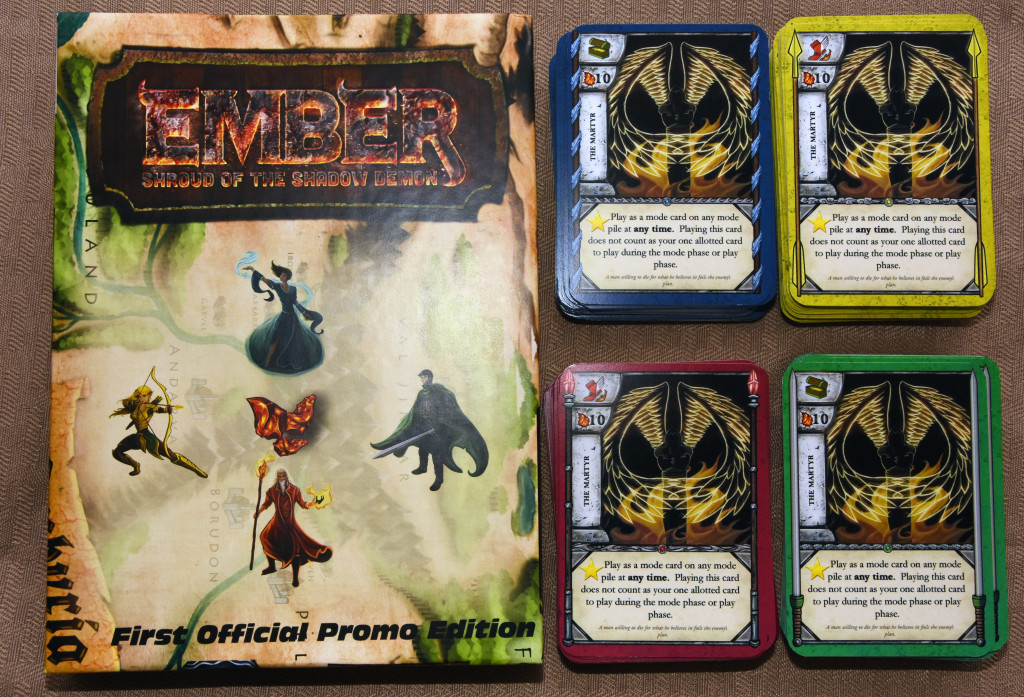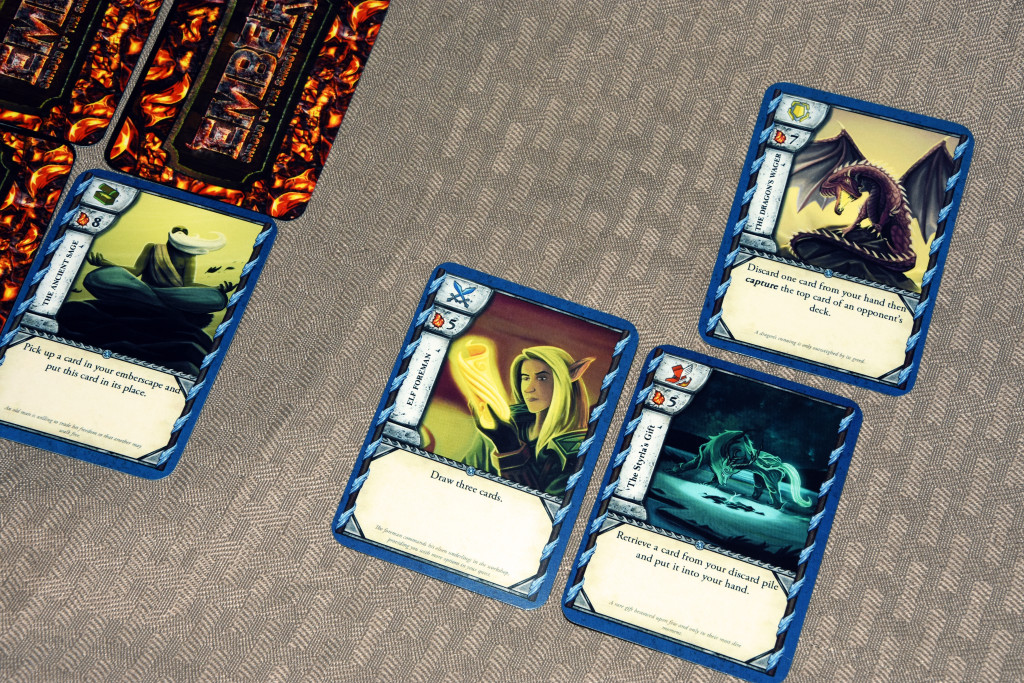Ingduhl, a “diabolical shadow demon” whose name rolls right of the tongue, must be stopped. That, dear player, is where you come in. In “Ember”, a game that’ll be seeking funding through the Kickstarter process sometime in July 2015, tasks players with collecting the most Ember stones in order vanquish this demon and win the game. Before we begin, I’d like to thank Josh Paugh, the co-owner of Paw-Warrior Games, for providing me with a prototype for preview purposes. It’s important to stress that prototypes are not often reflective of the final product, making everything you see in the article (including the rules)subject to change.
Firstly, let’s talk components. My prototype copy came with four different decks (blue, yellow, green, and red) representing four different “factions” for lack of better term. Each faction has common cards that will show up no matter which one you decide to pick, but they also contain unique cards that will redefine how that deck is to be played. At the beginning of the game, each player will choose a deck and shuffle it up. Then, four cards are drawn face-down off to the player’s left…they become their “arcane cards”. Then, they draw five cards to form their starting hand. Players will also reserve space for five cards in front of them, which will be known as their “Emberscape”. Above their Emberscape row is another empty space reserved for the “Mode Pile”.
The game itself is broken up over a series of turns and a player’s turn is broken up into five phases:
1. During the first phase or collection phase, the active player will check to see if their Emberscape is full. If it is, they’ll collect ALL the cards there and place them face-down into their collection/score pile. An arcane card can also be flipped over if the player collects their entire Emberscape during the collection phase.
2. During the second phase or mode phase, the active player can play a card from their hand, face-up, onto their mode pile (if the pile is empty, they MUST play a card). The card effect is not activated. Modes provide various abilities that change depending on the mode symbol shown…protection mode, for example, prevents other players from stealing, capturing, or destroying your own cards.
3. During the third phase or draw phase, the active player draws a card.
4. During the fourth phase or play phase, the active player chooses a card from their hand and plays it onto their Emberscape. The card effects are carried out in the order listed.
5. During the fifth phase or the end phase, the active player must discard down to nine cards. If the player has no cards, they may draw two.
Turns continue until someone reveals their last arcane card (though the effects are still carried out). Players then count the number of ember stones in their collection pile and whoever has the most, wins! It’s important to stress that I didn’t cover ALL of the rules found in the manual, but the above should give you a general idea as to how the game is played.
While I generally don’t review prototypes, I will go on the record and say that “Ember” hits a sweet spot in terms of complexity and game length. I generally don’t play games that take more than hour and much prefer micro-games that can be played in about fifteen minutes, just because my schedule is so darned hectic. While “Ember” is not a micro-game, it offers enough variety to keep things interesting but doesn’t drag on like some other card games do.
Take your modes for example…players can choose between one of four symbols or modes that will specialize them a bit. Players in “attack mode” can collect the cards in their Emberscape as soon as its full rather than wait for their next collection phase. Utilizing this strategy, players can potentially end the game sooner than usual and prevent another player from scoring on their next turn (assuming they had enough Ember cards to do so). The same could be said about “hasty mode”, as players need only collect three cards (instead of five) in order to claim them for their collection pile.
Then there’s the cards themselves. Not only does each faction have their own unique cards, some of them have permanent effects so as long as they remain in the Emberscape. This may encourage players to play these cards early and stay out of the aforementioned attack and hasty mode in order to keep that card in the Emberscape as long as possible. Some cards can be played in response to other card effects, giving other players something to do when it is not their turn. Or, if you’re feeling downright aggressive, you can attack other players with say, a lethal assassin card. Lastly, you can capture enemy cards and any lasting effects become your own. It goes without saying that there’s a lot to consider here.
In summary, I enjoyed my time with “Ember” and look forward to seeing what the finish product will look like (assuming the game reaches its Kickstarter goal). Speaking of which, you can learn more about and support “Ember” by visiting its Kickstarter page, here:
https://www.kickstarter.com/projects/paw-warriorgames/ember-shroud-of-the-shadow-demon
—


